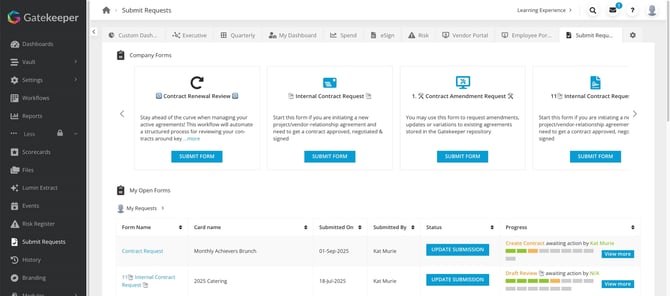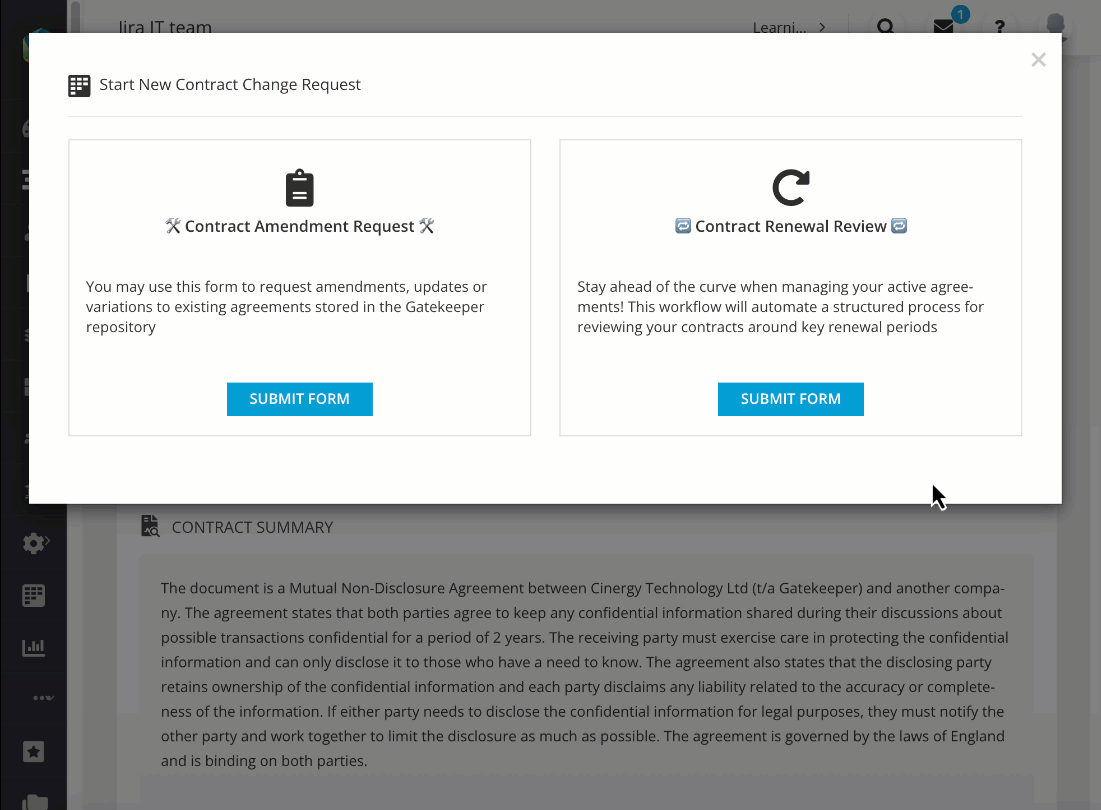Employee Portal Overview
This article provides an overview of what's available as part of the Employee Portal module.
![]() Estimated Read Time: 6 minutes
Estimated Read Time: 6 minutes
Sections in this article:
- What is the Employee Portal?
- The Submit Requests Dashboard
- Submit a Request from a Contract Record
- Employee Portal vs. Public Forms
What is the Employee Portal?
The Gatekeeper Employee Portal is an add-on module that simplifies the intake process in your organisation. This provides a central hub where employees can submit and track requests using easy-to-complete forms, which feed directly into Gatekeeper’s workflow engine.
Key Features
With the Employee Portal module:
- Regular Gatekeeper users benefit from a simplified way of submitting request forms through the additional Submit Requests dashboard, a centralised hub of request forms with real-time tracking. See the Submit Requests Dashboard section below for further detail.
- They can submit change requests directly from a contract record, saving time and ensuring requests are captured efficiently. See the Submit a Request from a Contract Record section below for further detail.
- You can also create Employee Portal Only users, who access a simplified interface without the main tenant’s navigation options. See Employee Portal Features for further details.

- The Employee Portal works seamlessly with existing Gatekeeper features. Requests are routed through workflows to the correct teams, notifications keep all parties informed, and approved requests automatically create contract or vendor records. This reduces admin overhead while maintaining a complete audit trail.
Note: If this module is unavailable and you are considering an upgrade, please contact us for more information.
The Submit Requests Dashboard
When the Employee Portal is enabled, the Submit Requests dashboard appears as an option in the navigation menu and can be set as the default landing page at login.

The dashboard features two main modules:
- Company Forms: displays a list of all forms that are available for submission, for example new contract or amendment requests.
- My Open Forms: displays forms that have been submitted, including trackers to monitor progress. This can be filtered to show:
- My Requests: Shows cards created by the user. This allows you to keep track of progress, even if the card is in a workflow or phase that is not visible to you.
- My Team’s Requests: Shows cards created by users in the same team. This allows you to keep track of progress, even if the card is in a workflow or phase that is not visible to you.
-
- All: Displays all cards the user currently has access to, irrespective of creator.
Submit a Request from a Contract Record
Users can initiate a contract change request directly from an existing contract, enabling early renewals or amendments to be actioned on demand.
After clicking Send to Workflow, the user will see a list of forms that are available for submission. They can select the relevant request type and complete the form without leaving the contract record.

Employee Portal vs. Public Forms
In addition to improving user experience, the Employee Portal offers enhanced security when compared to Public Forms. Since you control who has access to your forms, you can be confident that submissions come only from authenticated users within your organisation.
As a result of this, there are some additional benefits to using the Employee Portal over Public Forms:
- Enable Lumin Intake: Users can upload a file, then LuminIQ automatically extracts metadata to populate core contract fields in the request form. This eliminates manual entry and speeds up form completion.
- Auto-fill data from your repository: When users select existing records (i.e. vendors or contracts), Gatekeeper automatically pulls in their metadata from your repository. This saves time and prevents discrepancies by avoiding duplicate data entry.
- Add new vendor users: When entering vendor details into a form, users can add new vendor contacts by entering their name, job title, and email address. Gatekeeper only enables this option if the submitter is verified as part of your organisation, supporting secure data entry.
Additional Reading
- Configure the Employee Portal - Learn how to enable the Employee Portal, configure user permissions, and make workflow forms available for employees.
- Employee Portal Features - Learn about the experience for Employee Portal Only users.
- The Employee Portal on Gatekeeper Academy - For an in-depth overview of how to leverage the Employee Portal, take the e-learning course in the Gatekeeper Academy.
